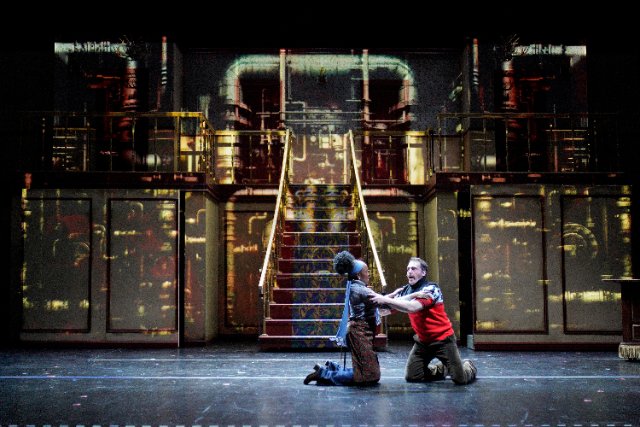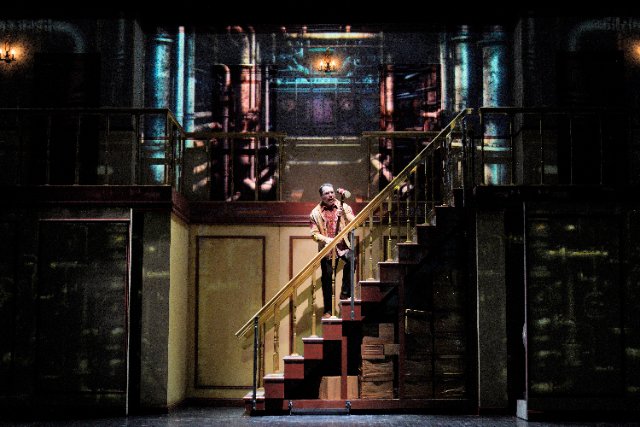The Shining - an Opera
Horror is Added to the Traditional Operatic Themes of Love, Conflict, and Death
By: Victor Cordell - Jun 03, 2023
Three threads have dominated the history of opera – love, conflict, and death. A less frequent theme is horror, yet sometimes that genre seems ripe for operatic exploitation, especially when it includes the other elements mentioned. Such is the case with Stephen King’s “The Shining,” a gripping novel of isolation and anxiety leading to fear and horror. Composer Paul Moravec and librettist Mark Campbell have created musical and dramatic tension that follows the novel. Since its commissioning by Minnesota Opera in 2016, two other companies have presented the original production.
Opera Parallèle has built its following based on three pillars – its deft selection of interesting underperformed or new material; the precise musical direction and conducting of Maestra Nicole Paiement; and the clever and original staging of Creative Director Brian Staufenbiel. The innovative OP has developed the first new production of “The Shining” with two partners, and it’s a treasure to see and hear - a visual phantasmagoria to fit the portentous score.
Jack Torrance, an unstable recovering alcoholic and unsuccessful writer, hires on as caretaker of the Overlook Hotel in the Colorado Rockies during its off-season. He hopes that the seclusion will not only give him undistracted time for writing but also allow him to rebuild his relationships with his wife, Wendy, and son, Danny. What the parents don’t realize is that Danny possesses “the shining,” which is the psychic ability of clairvoyance. This attribute will allow the boy to see the hotel’s sordid past and set the stage for the horrors to come. We will also learn of the damage done by generations of Torrance men that has led to familial horror.
Energetic baritone Robert Wesley Mason portrays Jack, and in addition to his passionate singing, he is tasked with acting a dramatic role that at first is a smiling, loving family man but that descends into rage. He accomplishes the task. Wife, Wendy, is played by soprano Kearstin Piper Brown, who excels in two small arias, importantly, an early one in which she reaffirms that despite their problems, she has always loved Jack.
In addition to the part of Danny, played by Tenzin Forder on opening night, the other key player is the cook, Dick Hallorann, who familiarizes the family with the kitchen facilities at the beginning and reappears in the final scenes. The cook also possesses “the shining” and provides sympathetic support for Danny. Hallorann is performed by wonderful bass-baritone Kevin Deas, who displays great range and sonorousness with a warm lower reach and a clear and buoyant upper, having an appealing vibrato.
The composer’s score is set in the modern mostly dissonant idiom, with the only hint of memorable melody coming during group or party scenes. However, the eerie and rumbling orchestral sounds create the desired sense of anxiety. Moravec alternates all sections of the orchestra to create disequilibrium – strings, winds, brass, and percussion. They shriek and whine and grind and thunder and bellow as appropriate. Paiement’s meticulous conducting is in evidence, whether in jabbing the air through staccato passages or sweeping through the lush ones.
However, the distinguishing feature of the production is the imaginative staging. You can picture Staufenbiel’s enthusiasm in dealing with such creative wealth and diversity. The canvas for the multimedia extravaganza is Jacquelyn Scott’s clever two-story interior set which symbolically hides secrets. The hotel is represented by a large staircase, doors, and several panels that open up to become pieces of other venues, from boiler room to kitchen. Jim French’s low lighting offers a notably understated quality, almost as if it’s hiding something. But the pièce de résistance is David Murakami’s brilliant projections, which are largely cast upon scrims that overlay the set. Variously, the scrimming brightly colors and shrouds and camouflages and distorts to add to the spooky effect. The culmination of Act 1 is especially effective, with a mass of characters on the catwalk singing in a cacophony of voices.
Lacking the vast toolbox of a movie production or the unfettered imagination of a reader, staging horror can suffer limitations, and having to overlay the conventions of opera make it even more difficult. In the case of the novel, the reader can slowly grasp the withering sense of desperate isolation that can drive a person over the edge, which is key to the narrative. But that element is not well developed in the libretto. While Danny, and then Jack’s, visions of past tragedies could have been presented as voices only to preserve the visual sense of isolation, the deceased are shown as phantoms. This does give the staging sparkle - a tawdry embellishment just short of campy that becomes the signature of the opera. A final visual element is Alina Bokovikova’s costumes, especially those of the deceased, largely in garish red and black like in a New Orleans cat house.
One shock scene does occur, but even that is telegraphed. However, while the horror element does not come across as strongly as it could, the revelations of incidents involving past caretakers unfolds like a disturbing mystery. Jack’s increasing violence and irrationality lead inexorably to a culminating conflict. The well-performed unsettling music and darkly kaleidoscopic visuals make for a highly interesting operatic experience.
“The Shining,” composed by Paul Moravec, libretto by Mark Campbell, based on the novel of the same name by Stephen King, and produced by Opera Parallèle in collaboration with Hawaii Opera Theatre and Portland Opera, plays at Yerba Buena Center for the Arts, 700 Howard Street, San Francisco, CA through June 4, 2023.






